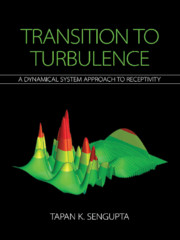Book contents
- Frontmatter
- Dedication
- Contents
- Preface
- 1 Receptivity, Instability, and Transition: A Perspective
- 2 Dynamical System Theory and Role of Equilibrium Flows
- 3 Fundamentals of Scientific Computing
- 4 Instability and Transition
- 5 Receptivity Analysis: Relation with Instability Experiments
- 6 Dynamical System Theory of Linear Receptivity
- 7 Nonlinear, Nonparallel Effects on Receptivity, Instability, and Transition
- 8 Three-Dimensional Routes of Transition to Turbulence
- 9 Receptivity to Free Stream Excitation: Theory, Computations, and Experiments
- 10 Nonlinear Receptivity Theories: Hopf Bifurcations and Proper Orthogonal Decomposition for Instability Studies
- 11 Mixed Convection Flow
- 12 Baroclinic Instability: Rayleigh–Taylor Instability
- 13 Coherent Structure Tracking in Transitional and Turbulent Flows
- 14 The Route of Transition to Turbulence: Solution of Global Nonlinear Navier–Stokes Equation
- References
9 - Receptivity to Free Stream Excitation: Theory, Computations, and Experiments
Published online by Cambridge University Press: 16 February 2021
- Frontmatter
- Dedication
- Contents
- Preface
- 1 Receptivity, Instability, and Transition: A Perspective
- 2 Dynamical System Theory and Role of Equilibrium Flows
- 3 Fundamentals of Scientific Computing
- 4 Instability and Transition
- 5 Receptivity Analysis: Relation with Instability Experiments
- 6 Dynamical System Theory of Linear Receptivity
- 7 Nonlinear, Nonparallel Effects on Receptivity, Instability, and Transition
- 8 Three-Dimensional Routes of Transition to Turbulence
- 9 Receptivity to Free Stream Excitation: Theory, Computations, and Experiments
- 10 Nonlinear Receptivity Theories: Hopf Bifurcations and Proper Orthogonal Decomposition for Instability Studies
- 11 Mixed Convection Flow
- 12 Baroclinic Instability: Rayleigh–Taylor Instability
- 13 Coherent Structure Tracking in Transitional and Turbulent Flows
- 14 The Route of Transition to Turbulence: Solution of Global Nonlinear Navier–Stokes Equation
- References
Summary
Introduction to Free Stream Excitation
The receptivity to free stream disturbances was introduced in Chapter 5 from the perspective of its role in creating TS waves. This problem is addressed by few researchers due to the failure reported in the experiments of [405]. Its authors could not create TS waves by acoustic excitation from the free stream, as was theoretically predicted earlier by Tollmien and Schlichting using linear spatial instability theory.
Reasons for these are many-fold: first, an acoustic wave is three-dimensional and thus does not excite two-dimensional TS waves. Free stream excitation is not monochromatic, and the linear spatial theory demands monochromatic excitation. It is shown in Sub-section 5.3.2 that receptivity of the laminar boundary layer to free stream disturbance convecting with free stream speed shows very weak coupling, unless one follows the bypass route (convection speed is significantly lower than the free stream speed). Experimental work also started with that reported in [510]; to estimate the dependence of critical Reynolds number on free stream turbulence (FST). While discussing Taylor's work in [295], the authors (of this treatise) conjectured that FST consisting of convected vortices is responsible for creating adverse pressure gradients locally, which gives rise to unsteady separation. Such separations trigger the rapid vortex-induced instability leading to transition. The assumption in [295] is that the “effect is connected with the generation of fluctuations of longitudinal pressure gradient by these disturbances, leading to the random formation of individual spots of unstable S-shaped velocity profile.” Exciting a shear layer by sources outside it has been experimentally investigated later in [109, 225, 226, 267].
Dietz [109] created disturbances inside the boundary layer by vibrating a ribbon in the free stream at a single frequency. This is supposed to supplement the experiment in [405] to create TS waves by free stream excitation at a monochromatic frequency. Dietz [109] actually did not demonstrate progressive TS wave, and instead plotted velocity profiles which looked like the TS wave eigenfunctions, shown in [412]. It is pertinent to note that even the STWF displays a velocity profile in [29], which has the same wall-normal distribution of streamwise disturbance velocity. So the demonstration in [109] is qualitative only. In Sub-section 5.3.2, the coupling mechanism between wall and free stream excitation is explained.
- Type
- Chapter
- Information
- Transition to TurbulenceA Dynamical System Approach to Receptivity, pp. 288 - 342Publisher: Cambridge University PressPrint publication year: 2021



